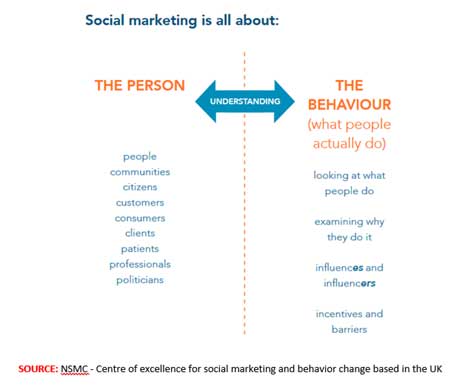
Digital Marketing {The Ultimate Guide} by a Reno Digital Marketing Expert Part 3
Chapter 3: Social Marketing (SM)
INTRODUCTION
Several decades ago (back in the 1940s and 1950s), Social scientists and Behavioral analysts began studying the impacts that societal norms have on individual and group psyche, and vice versa. Thought leaders realized that, by understanding how individuals and groups think, perceive and act upon certain facts, influencers can change, or maintain, behavioral traits of those individuals and groups.
This provided interest groups, such as politicians and marketers, a vital tool to use in conducting their business. It was the beginning of the Social Marketing (SM) revolution.
WHAT IS SOCIAL MARKETING (SM)
Before we discuss what SM is all about, let’s clarify what it is NOT. Social Marketing is not the same[i] as marketing using Social Media tools, or Social Media Marketing (SMM). While there may be several overlaps between SM and SMM, these are two distinct marketing approaches.

SM is an approach that uses strategies and tactics to effect mind-set changes, or reinforce already existing ones[ii], in behavioral patterns of individuals and groups. The use of SM helps commercial marketing entities, such as online marketers, decide:
- Which audience to influence (e.g.: Boomers, Millennial’s, Gen-X or Gen-Y, Males, Female professionals)
- What behavioral change, or reinforcement of existing behavior, will yield the best result (e.g.: Encouraging plant-based proteins over animal-based ones)
- How to effect that change (e.g.: Educate, Promote, Demonstrate, Encourage)
- How to measure the success of intended change
The ultimate objective of SM is to effect change in, or entrench existing, behavior, in a way that it benefits individuals and society. It is not primarily about raising awareness or disseminating knowledge – which is the central objective of SMM. In the process however, Social Marketers do use Social Media as a tool (a very important one) to achieve their objectives.
HOW DOES SOCIAL MARKETING WORK?
Social Marketing uses a well-defined process, not unsimilar to many other commercial marketing approaches, to change or reinforce individual or group behavior.

Here’s how it works[iii]:
- Before launching a SM campaign, you must plan your approach, including deciding what the key outcomes are that you wish to accomplish (e.g.: Switching people’s choice of toothpaste or the brand of coffee they like)
- Decide on the scope of your campaign, which includes identifying which interventions to pursue
- You then set specific goals and targets that you must achieve as a result of the campaign. These goals are typically SMART goals – Specific, Measurable, Achievable, Realistic and Time-bound
- The implementation phase is where you launch your campaign. You may select various SMM tools to implement your strategy, including Facebook, Instagram, Pinterest etc.
- You closely monitor and evaluate the result of your SM campaign, and match them against the desired outcomes you targeted in Step#1 above. If there are significant deviations in perceived outcomes, it is critical to adjust your strategy during implementation
- Finally, you must follow-up on any results that you documented as a result of the campaign. For instance, if the feedback is that your website does not have actionable content or helpful tools, you must make necessary changes and monitor the impact of those changes
Each SM campaign may differ in the exact steps performed. You may implement some phases sequentially, while others – like Implement and Evaluate – may run in parallel. However, all 6-steps are essential.
WHY SOCIAL MARKETING MATTERS
Most marketers think that by allocating massive budgets for Social Media advertising campaigns, or by saturating their presence on Google Ads, they will dominate market share. Not true!
If you want to effect real change in social behavior, you must first understand what that behavior is, who exhibits it, where do they typically mingle (cohabitate) and how to influence it. Then – and only then! – can you make real behavioral change.
Social Marketing is key to effective marketing, whether you sell online, or at bricks and mortar stores. Done properly, SM is highly effective in determining the 4-Ps of your business. Without SM, you may not get the return on investment (ROI) you are looking for on for your marketing investments.
CHAPTER SUMMARY
While Social Marketing (SM) is often confused for Social Media Marketing (SMM), the two are not the same. Neither is SM the same as using social media platforms to conduct marketing activities. It is a deliberate process of identifying your target audience, and then strategizing what behaviour to change, and how to effect those changes to accomplish your marketing objectives. SM however does use SMM as a tool in its strategy.
Contact SM expert Sandy Rowley, at Reno Web Designer, to discuss how SM can help you make your online marketing more effective.
COMMON TERMS & TERMINOLOGY
- 6-stage SM Process: A series of sequential steps, which includes Getting started, Scope, Develop, Implement, Evaluate and Follow-up, used during a SM engagement
- Social advertising: Leveraging advertising channels to accomplish objectives that are beneficial to individuals and society
- Behavioral change: Achieving modification or change in existing behavior, or success in adoption of new habits and preferences
- SMART behavioral objectives: Targeting behavioral change that is specific, measurable, achievable, realistic and timebound (SMART)
- Demographics: The traits of the specific audience, such as age, sex, ethnicity, culture or income, that a SM campaign targets
- Customer journey maps: A process, within SM, that tracks and analyzes customer reactions, responses and experiences from their interactions with your product, service or web presences
- Segmentation: A SM technique that divides your target demographics into sub-groups (e.g. Males between the age of 18 to 24; or families earning $60,000 and above). This information then drives the formulation of specific SM interventions required to change targeted behavior or preferences
- 4-Ps: Refers to the optimal combination or mix of Product, Price, Promotion and Place that SM strategies seek to identify or confirm
- Social insight: A deep understanding of potential customers’ habits, likings, disliking’s and preferences that the SM process uncovers
- Strategic Social Marketing: Using SM to bring intervention into policy-making and priority-setting activities of governments, lobby groups and lawmakers
[i] https://www.viralseeding.com/social-marketing-vs-social-media-marketing/
[ii] https://www.thensmc.com/about-us
[iii] https://www.thensmc.com/sites/default/files/Big_pocket_guide_2011.pdf (page 79)




